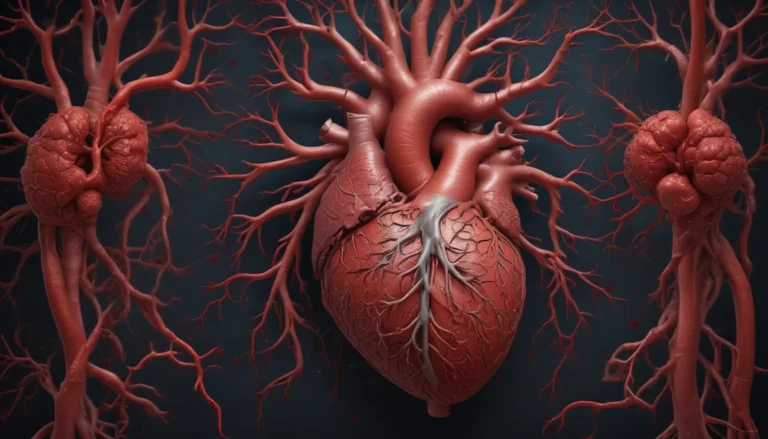A Note About Images: The images used in our articles are for illustration purposes only and may not exactly match the content. They are meant to engage readers, but the text should be relied upon for accurate information.
If you have ever been curious about the inner workings of cells or are a biology enthusiast, the endoplasmic reticulum (ER) is a topic worth exploring. This remarkable organelle plays a crucial role in protein synthesis, lipid metabolism, calcium homeostasis, and cellular signaling. What makes the ER even more fascinating is its ability to precisely target specific proteins and lipids to their correct destinations within the cell. In this article, we will delve into the intricate world of ER targeting and uncover 11 astonishing facts that shed light on this complex process.
Unlocking the Mysteries of ER Targeting
The ER is a vital component of eukaryotic cells, forming an extensive network of membranes in the cytoplasm. It is involved in various cellular functions, including protein synthesis, lipid metabolism, and calcium storage. One of the most intriguing aspects of the ER is its role in ensuring proper protein localization through ER targeting mechanisms.
The Significance of ER Targeting in Protein Localization
Proteins synthesized in the ER must be accurately targeted to their specific destinations within the cell to carry out their functions effectively. ER targeting mechanisms play a crucial role in this process, ensuring that proteins reach their intended locations such as the plasma membrane or the Golgi apparatus.
Understanding Signal Peptides in ER Targeting
Signal peptides are short amino acid sequences located at the beginning of a protein that act as “address labels” directing the protein to the ER for proper targeting. These sequences play a vital role in the integration of proteins into the ER membrane.
The Role of Signal Recognition Particles (SRPs)
Signal recognition particles (SRPs) are protein-RNA complexes that recognize and bind to signal peptides of newly synthesized proteins. They guide the ribosome to the ER membrane, where the protein is inserted and further processed to facilitate proper targeting.
Hydrophobic Amino Acids in ER Targeting
Hydrophobic amino acids are commonly found in ER signal sequences, allowing the signal peptide to interact with the ER membrane. This interaction facilitates the targeting and insertion of proteins into the ER, ensuring their proper localization.
Ensuring Proper Functionality of Membrane Proteins
The ER is responsible for synthesizing membrane proteins, essential for functions like cell signaling and transport. Ribosomes bound to the ER membrane ensure the direct integration of membrane proteins into the lipid bilayer, maintaining cellular processes.
Quality Control Measures in ER Targeting
Misfolded proteins are detected by quality control mechanisms in the ER and targeted for degradation through ER-associated degradation (ERAD). This process ensures that only properly folded proteins reach their intended locations within the cell.
Implications of ER Targeting in Health and Disease
Disruptions in ER targeting mechanisms can have significant implications for health, leading to the mislocalization or aggregation of proteins and contributing to various diseases. Conditions such as Alzheimer’s disease, Parkinson’s disease, and cystic fibrosis are examples of disorders associated with defects in ER targeting.
Viral Exploitation of ER Targeting
Viruses often exploit the cell’s ER targeting mechanisms to enhance their replication and spread. By utilizing ER targeting pathways, viruses can replicate their genetic material and form new viral particles within the ER, leading to infection and disease.
Regulation and Complexity of ER Targeting
The process of ER targeting is highly complex and carefully regulated within cells to maintain proper protein localization. Errors or disruptions in this process can have profound consequences for cell function and overall health, underscoring the importance of understanding ER targeting mechanisms.
Unveiling Novel Aspects of ER Targeting Through Research
Advances in research continue to unveil novel aspects of ER targeting, shedding light on additional factors, signaling pathways, and regulatory mechanisms involved in this fundamental cellular process. Ongoing studies provide insights into the intricate details of ER targeting, deepening our understanding of cellular function and biology.
Conclusion: Navigating the Intricacies of ER Targeting
In conclusion, the endoplasmic reticulum (ER) stands as a remarkable organelle with crucial functions in cellular processes. ER targeting mechanisms ensure the precise delivery of proteins to their intended destinations within the cell, contributing to proper protein synthesis and functionality. By unraveling the intricate world of ER targeting, we gain valuable insights into the mechanisms governing cellular function and the complexities of biology.
FAQs: Exploring ER Targeting Perspectives
-
What is endoplasmic reticulum (ER) targeting?
ER targeting is the process by which proteins are transported to the ER for modifications and folding necessary for their proper function. -
How do proteins get targeted to the endoplasmic reticulum?
Proteins destined for the ER possess specific targeting signals, such as signal peptides, guiding them to the ER membrane for translocation. -
What happens during ER targeting?
During ER targeting, proteins are recognized by targeting factors for transport across the ER membrane, allowing them to undergo folding and modifications for functional conformation. -
Why is ER targeting important?
ER targeting is crucial for proper protein synthesis and functioning, ensuring proteins are correctly folded and modified to carry out specific roles within the cell. -
Can defects in ER targeting lead to diseases?
Yes, defects in ER targeting can contribute to various diseases, disrupting normal cellular processes and leading to conditions like neurodegenerative disorders. -
Are there any drugs that target the ER?
Yes, drugs targeting the ER have been developed to treat diseases related to ER stress, aiming to restore ER homeostasis in conditions like diabetes and cancer. -
Can the ER be targeted for genetic engineering purposes?
Yes, the ER can be targeted for genetic engineering, enhancing the production of recombinant proteins or biofuels by manipulating ER targeting signals. -
Does the ER play a role in lipid metabolism?
Yes, the ER is involved in lipid metabolism, synthesizing lipids and serving as a storage site for lipids within the cell. -
Can the ER regulate calcium levels?
Yes, the ER regulates calcium levels, acting as a calcium reservoir and releasing calcium ions for cellular signaling when needed. -
Are there different types of ER targeting signals?
Yes, different types of ER targeting signals exist, including signal peptides, transmembrane domains, and specific amino acid sequences guiding proteins to the ER. -
How is ER targeting regulated?
ER targeting is tightly regulated by cellular mechanisms such as chaperones, translocation machinery, and quality control systems ensuring accurate delivery and proper folding of proteins within the ER.
In our commitment to delivering trustworthy and engaging content, the facts shared on our site are contributed by real users like you, ensuring a wealth of diverse insights and information. Our dedicated editors meticulously review each submission, guaranteeing the highest standards of accuracy and reliability for a credible and authentic learning experience. Trust in our commitment to quality as you explore and learn more about the fascinating world of ER targeting.






